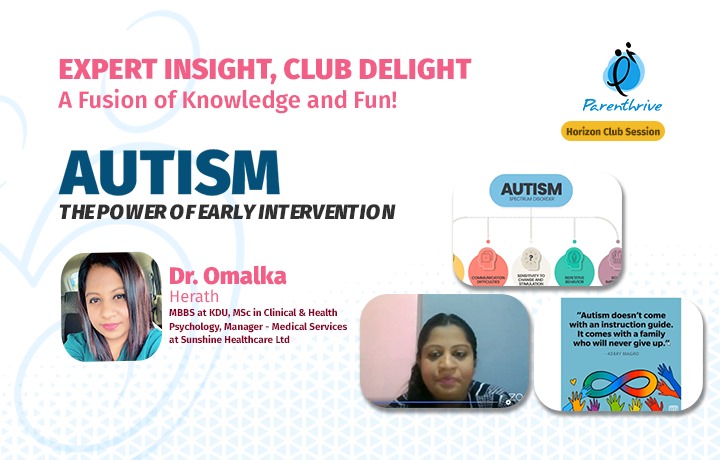
Understanding Autism Spectrum Disorder (ASD)
Parenthrive held a session on the importance of early intervention regarding autism in kids. Done by Dr. Omalka Heath (MBBS) (MSc in Clinical & Health Psychology), the session featured many important aspects of preventative care and recognition of symptoms. The session was held on the 16th of June via Zoom and attended by Parenthrive members and interested parties alike.
Autism Spectrum Disorder (ASD) is a complex neurodevelopmental condition characterized by difficulties in communication, social interactions, and behavior. As a spectrum disorder, ASD manifests in various forms and intensities, affecting individuals differently. With appropriate support and interventions, individuals with autism can achieve significant progress and lead fulfilling lives.
History and Prevalence of Autism
The term "autism" was first introduced by Eugen Bleuler in 1908. Leo Kanner's 1943 paper described "early infantile autism," and Hans Asperger's 1944 work identified what is now known as Asperger's syndrome. Autism research has evolved significantly, with the DSM-5 consolidating autism, Asperger's, and childhood disintegrative disorder into a single diagnosis: Autism Spectrum Disorder.
Autism prevalence has increased over the years, with the U.S. CDC reporting that approximately 1 in 110 children were diagnosed with ASD as of 2009.
Early Signs and Risk Factors
Early identification of autism is crucial. Parents should monitor their child's developmental milestones and look for signs such as delayed speech, lack of social interaction, and repetitive behaviors. Common risk factors include genetic predispositions, environmental factors, and parental age.
Screening and Diagnosis
There is no definitive medical or laboratory test for diagnosing autism. Instead, standardized screening tools and professional assessments are used:
- M-CHAT-R: For toddlers aged 16-30 months.
- SACS-R and SACS-PR: For children aged 12-60 months.
- SCSQ: For school-aged children.
- AQ Test: For individuals 16 years and older.
The American Academy of Pediatrics recommends screening all children for autism at 18 and 24 months during regular well-child visits.
Interventions for Autism
While there is no cure for autism, various interventions can significantly improve quality of life. Early Intensive Behavioral Intervention (EIBI), a form of Applied Behavioral Analysis (ABA), is particularly effective for children under five. EIBI combines structured and unstructured teaching to enhance IQ, adaptive behavior, socialization, and communication skills.
Other essential interventions include:
- Behavioral Therapies: Address behavioral challenges and improve social skills.
- Occupational Therapy: Focuses on fine motor skills and sensory integration.
- Speech and Language Therapy: Enhances communication abilities.
- Physiotherapy: Aids in physical development and coordination.
- Complementary Therapies: Such as animal therapy, art therapy, and music therapy.
Educational Strategies
Education for children with autism should be inclusive and supportive, ranging from mainstream inclusion with support to specialized private schooling. Tailored educational plans can help children thrive in academic settings.
Challenges and Coping Strategies
Children with autism often face challenges such as meltdowns, mood changes, noise sensitivity, sleep problems, anxiety, and difficulty dealing with changes. Addressing these challenges requires consistent routines, positive reinforcement, and engaging in activities that promote social and emotional development.
Role of Parents
Parents play a crucial role in their child's development. They should:
- Love and accept their child.
- Use positive reinforcement.
- Maintain consistent routines.
- Engage in shared activities.
- Allow time for adjustments.
- Seek support when needed.
Early identification and intervention are vital for optimizing developmental outcomes in children with autism. By understanding the signs, utilizing effective screening tools, and implementing tailored interventions, parents and professionals can significantly enhance the quality of life for individuals with autism, enabling them to reach their full potential.






